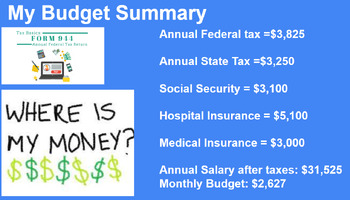Budget Portfolio - Percents, Fractions, and Decimals
- Google Slides™

Description
Step into the world of practical math with my meticulously crafted 'First Job Budget Portfolio Project' designed for 6th and 7th-grade classrooms. This engaging project seamlessly weaves percents, fractions, and decimals into the fabric of real-world decision-making. Students assume the role of a 22-year-old recent college graduate, celebrating their first job and embarking on the journey of creating a monthly budget based on their first annual salary. Aligned with specific 6th and 7th-grade Common Core Standards for Mathematics, this project not only facilitates a deep understanding of mathematical concepts but also cultivates critical research and digital presentation skills. With guided links, Google Slides templates, and an exemplar for reference, students navigate the intricacies of budgeting, ensuring their numbers are approved before finalizing their finished product. Elevate your math curriculum with a project that not only meets academic standards but empowers students with the essential life skills needed for financial success in the real world!





